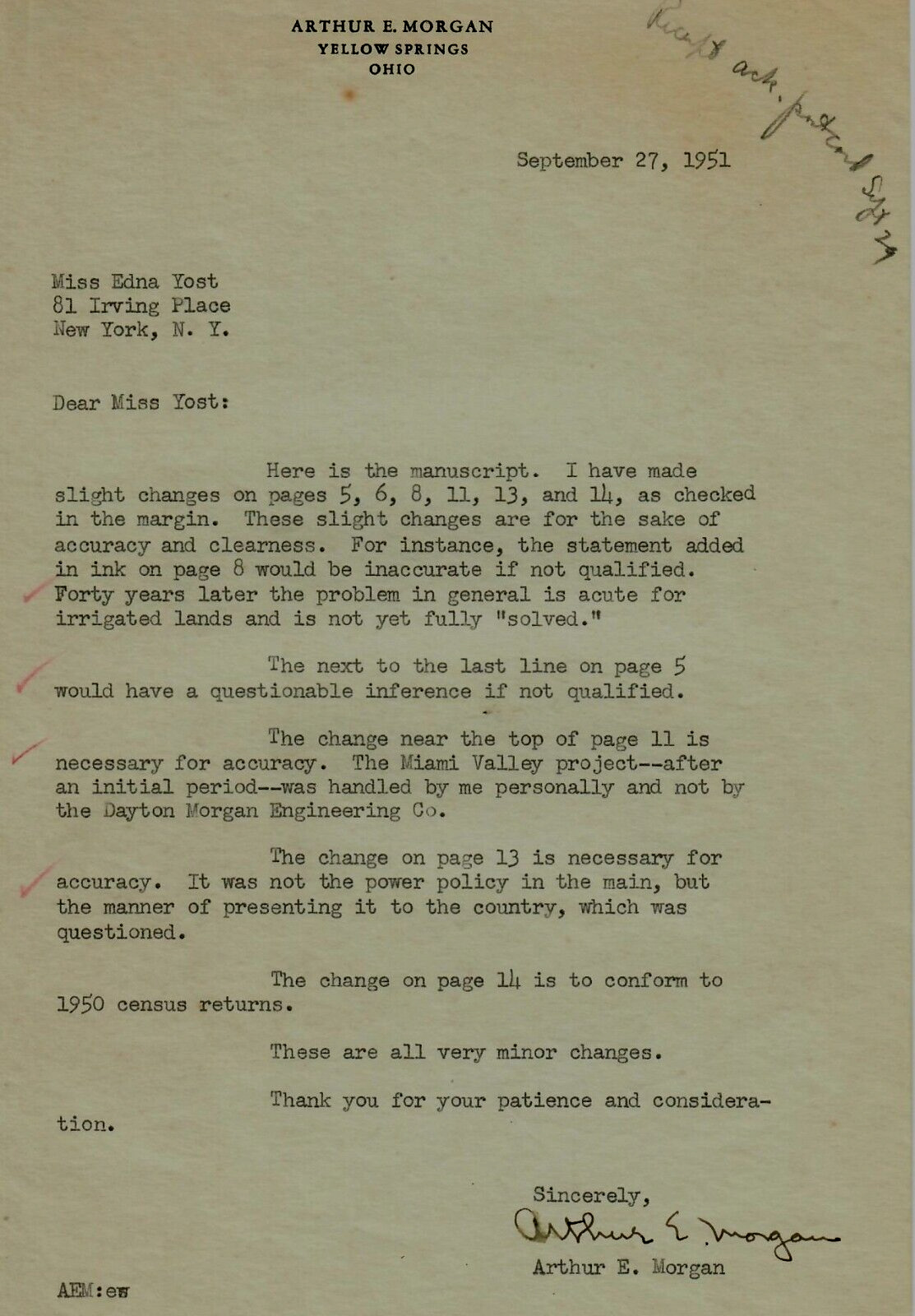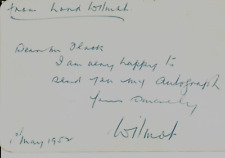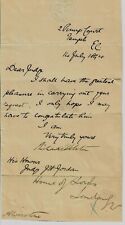When you click on links to various merchants on this site and make a purchase, this can result in this site earning a commission. Affiliate programs and affiliations include, but are not limited to, the eBay Partner Network.
Up for sale "Antioch College" Arthur Morgan Hand Signed TLS Dated 1951.
ES-6443E
Arthur
Ernest Morgan (June 20,
1878 – November 16, 1975) was a civil engineer, U.S. administrator, and educator. He was the design
engineer for the Miami Conservancy District flood
control system and oversaw construction. He served as the president of Antioch College between 1920 and 1936. He was also Valley Authority from
1933 until 1938 in which he used the concepts proven in his earlier work with
the Miami Conservancy District. Arthur E. Morgan was born near Cincinnati, Ohio but his family soon moved to St. Cloud, Minnesota.
After graduating from high school, he spent the next several years doing
outdoors work in Colorado. During this time he learned that
there was a dearth of practical understanding of hydraulic engineering. He
returned home and took up practice with his father, learning about hydraulic
engineering by apprenticeship. By 1910 he had founded his own firm and become
an associate member of the American Society of Civil Engineers. After the
disastrous Great Dayton, Ohio Flood in
1913, Morgan proposed a system of dry earthen dams to control the river systems
above Dayton. His concepts were challenged because of his lack of formal
engineering training, but eventually his plans were adopted and constructed,
and the subsequent years proved the effectiveness of his concepts. Because of
this success, he was chosen in 1933 to design and deploy the Tennessee Valley
system of dams for flood control and electrification. Always interested in
progressive education, he sent his son Ernest to Marietta Johnson's Organic School in Fairhope, Alabama, a
pioneering progressive boarding school. Morgan's first effort in education was
to found the Moraine Park School, an experimental progressive school in Dayton,
in 1917. In 1921, Morgan became the first president of The Association for the
Advancement of Progressive Education, later renamed in 1931 as Progressive Education
Association (PEA). In 1919, Morgan accepted the presidency
of Antioch College to turn it around after a low point in the college's
finances. Morgan replaced the existing board of trustees, which had been
dominated by quarrelsome local ministers, with prominent businessmen such
as Charles Kettering, who had
also backed Morgan's efforts at the Moraine Park School. Between 1921 and 1933,
board members and their friends donated more than $2 million to Antioch.
Kettering alone donated $500,000. Morgan reorganized the educational program to
include cooperative education and
involved faculty in industrial research. The faculty, most personally chosen by
Morgan, included not only academics but also architects, engineers, chemists,
advertising executives, and government bureaucrats. Until
around the 1930s, Morgan was a member of the Unitarian Church. In his later life, Morgan was a Humanist Quaker, a member of the Society of Friends in Yellow Springs, Ohio, as
was his son Ernest. After his departure from the TVA in 1938, Arthur Morgan was
active in Quaker war relief efforts in Mexico and Finland. Among other
accomplishments in the 1940s, he founded a non-profit organization to promote
small communities (Community Service, Inc.), helped to set up a system of rural
universities in India, and fought to protect Native American (Seneca) land from
the flooding by the U.S. Army Corps of Engineers. Morgan was the author of more
than twenty books. Two in the water field demonstrated his environmental
orientation and his criticism of the Army Corps. In 1962 Morgan's
daughter-in-law, Elizabeth, with the help of his son Ernest, founded a
progressive private school with humanist, Quaker, and Montessori influences,
naming it the Arthur Morgan School. Along
with J.J. Tigert, Morgan served
as a member of the Indian University Education Commission set up in 1948
with S. Radhakrishnan as a
chair and Zakir Husain as a
member. The commission studied Land-Grant colleges in agricultural education in
the United States. He travelled across India in 1948 as part of the commission
and also supported a community education initiative in Kerala called
Mitraniketan begun by K. Viswanathan in 1965. Morgan was a leading community
organizer in the postwar period. He was deeply committed to community and
greatly interested in community settlements. Heavily influenced by Edward Bellamy’s Looking Backward, Morgan gained a reputation as a Utopian
dreamer. This interest in community living, coupled with Morgan’s belief in
small towns and family life as the most virtuous form of living, led Morgan to
participate in several projects that fostered rural community life. As
chairman of the TVA, he not only directed
the building of dams and provided power; he promoted community living as well.
Morgan advanced a wide variety of cooperative enterprises and cottage industries and
created a number of planned towns that followed the English garden city model.
In 1937, Morgan founded Celo Community, a land trust in the mountains of Western North
Carolina. The community, which still exists today, is a self-governed land
trust. Although Celo does not require members to accept any particular
religious creed or ideology, it is built on cooperation between members and
care for the natural environment. Today, Celo is home to 40 families who live on
its 1,000 acres (4 km2). In the 1940s, Morgan went
on to found two organizations for the promotion of community, Community Service
Inc. (CSI) in 1940, and in 1949 the Fellowship of Intentional Communities
(FIC). CSI was created to advance family life and small towns, which Morgan saw
as the necessary ingredients for a positive American future. The organization
was founded on Morgan’s belief in the importance of small towns to the rapidly
urbanizing nation. Small towns, he argued, provided places for people to
experience respect, cooperation, and personal relationships. In the same year,
Morgan founded the Fellowship of Intentional Communities, an organization that
fostered relationships between communal settlements. The FIC cultivated communication
and the exchange of products between communities, promoted communication
between communal settlements and the outside world, and advocated for the
formation of new intentional communities.




































